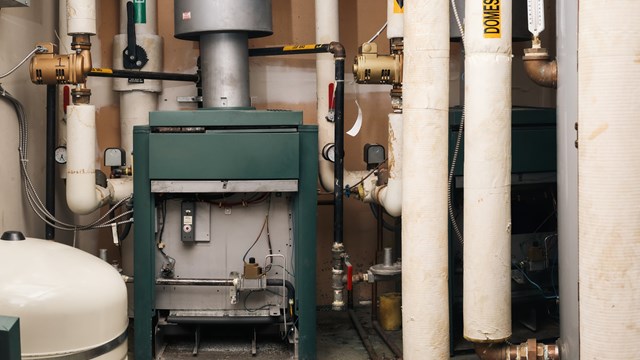
The Community Associations Institute’s Big Apple chapter (www.bigapplecai.org) met on Tuesday, March 1 at the General Society of Mechanics & Tradesmen library in Midtown to discuss emotional support animals and ridding your building of drafty ventilation and energy-wasting conditions.
The group’s monthly seminar series featured attorney David J. Byrne, a partner with Ansell Grimm & Aaron, PC, a law firm with offices in White Plains and New Jersey, and Casey Birmingham, a senior project manager with the Energy/MEP division of The Falcon Group, an engineering, architectural and energy consulting firm with offices in New York City, New Jersey and around the country.
Birmingham noted that buildings, especially those with older infrastructure, can be tremendous wasters of energy and electricity. He also said that buildings can fix problems associated with poor ventilation without a major overhaul.
Ooooh That Smell!
Some of the problems facing shareholders and unit owners in a communal living situation tend to be cigarette smoke and pungent cooking odors permeating the common areas and neighboring apartment units.
“What I’m here today to talk about is building ventilation,” Birmingham began. “Why it’s important and why it’s often overlooked. You could potentially be saving a lot of money in energy capital expenditure and also improve the comfort of the residents of your buildings—the indoor air quality.”
“People are often trying to find new ways to save energy. Some of the typical things that come to mind: lighting, changing out the major HVAC equipment. The problem with that is that there is a major upfront capital expense. The paybacks could be five, ten years. If you do an envelope improvement that’s also a major capital expense pushing you back sometimes up to ten years to pay for it.
“Ventilation is often overlooked. People don’t pay attention until suddenly your bathroom is steaming or you smell somebody else’s cooking smells from downstairs or in the hallway. Some of the good things about it is it’s often a pretty low upfront cost. It starts with balancing out equipment, making it run the way it should be running based on code requirements. Usually the paybacks are pretty significant. It’s pretty easy to implement, too. The savings is significant,” says Birmingham.
A building’s indoor air quality (IAQ) can be affected by having poor ventilation, as well, he says. Poor ventilation can cause a buildup in indoor air pollutants like dust, pollen, mold, and household chemicals.
Two types of ventilation are common, Birmingham notes, natural ventilation and mechanical ventilation. Most prewar buildings in New York City have natural ventilation (air infiltration by open doors and windows), and post-war, mechanical ventilation. Ventilation is not static, changing with conditions. Grilles and ducts on the air registers could be blocked or caked with dust and debris causing them to not function properly. Weather also affects ventilation as air leaks can occur through small openings or cracks in the building envelope. Owners during a renovation project sometimes seal up exhaust ducts which in turn can affect the airflow of the entire floor or line of apartments. And if you start messing with the exhaust fans, he says, it could have a negative impact on your neighbors.
And not to mention, cooking smells are a perennial building-wide problem in co-ops and condos, Birmingham says. A surefire way to address ventilation issues is to do an investigation to pinpoint problems. That could mean hiring a testing and balancing contractor. This professional is tasked with insuring that your HVAC system is performing correctly so that you have a comfortable and energy-efficient building.
Building staff, Birmingham added, could simply adjust the exhaust fans and also install what is called a constant airflow regulator (CAR), equipment which measures and balances air flow and indoor air quality. For example, The Visionaire, a LEED Platinum building in Lower Manhattan, developed in 2006 by The Albanese Organization and Starwood Capital, was built with a high-efficiency fresh air supply and exhaust system installed to recirculate the air and make it more breathable for residents. Other New York City LEED-certified buildings have this technology as well.
Accommodating Requests in a No-Pet Building
Byrne talked about one of the building community’s most contentious pet peeves: companion pets and emotional support animals. An emotional support animal, in contrast to a service dog for the deaf or blind person, is something that makes a person feel better physically or psychologically.
“The emotional support animal becomes complicated and difficult to address,” says Byrne, “because the relevant statutes require the housing, whether it’s a co-op or a condo, to make an accommodation in the rules, the practices of the building, to accommodate someone’s disability so they can have equal use and enjoyment of the dwelling. And many people, including myself, interpret that last part—the use and enjoyment of the dwelling—as a physical thing. Which is why a seeing eye dog would have to be accommodated, because you actually can’t physically use and enjoy your house if you can’t see. ” On the other hand, he says, using an emotional support animal does not deny the person use of their home.
Byrne cited two cases, one involving a Manhattan co-op where the proprietary lease and house rules prohibited pets. A shareholder suffered from post-traumatic stress disorder, had difficulty sleeping, and other emotional issues. A doctor rendered a medical opinion for her and the woman soon after picked up a stray dog, which made her feel better. She requested an accommodation from the board to keep the dog. The co-op sent a standard 10-day notice to cure due to violation of the no-pet policy.
The co-op ignored a second request and sent a 10-day notice to terminate her lease. The co-op petitioned the housing court to hear the matter and the woman again sought an accommodation, complaining to the federal Housing and Urban Development office. The housing court sided with the co-op, and the New York City’s Human Rights Commission, which received the complaint from HUD, concluded similarly that her use and enjoyment of the residence was not infringed upon. HUD, however, proceeded with an action declaring that her rights had indeed been violated.
The board in this instance made two major mistakes, says Byrne. First, they ignored the request, and secondly, they waited and in sending a second notice effectively denied the request.
“The first problem was that a shareholder made a request for accommodation. When a co-op gets that kind of request, you really should treat it as if the building’s on fire. It needs to marshal its resources, talk to its experts and really handle it a certain way and not ignore it.”
Remember, too, to take accommodation requests seriously. “You should never actually say no. You simply say you are investigating and considering the request,” says Byrne.
Debra A. Estock is managing editor of The Cooperator.









Leave a Comment